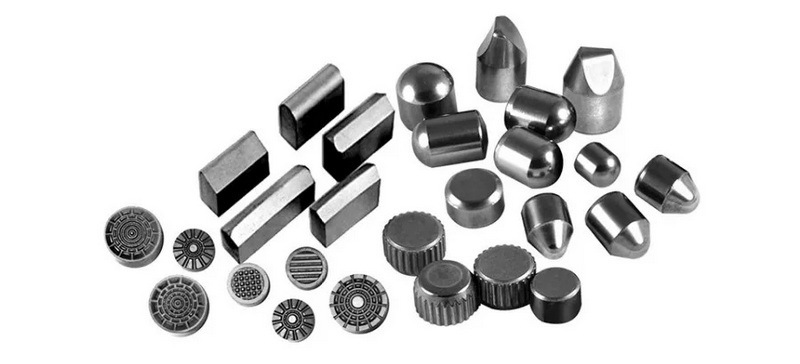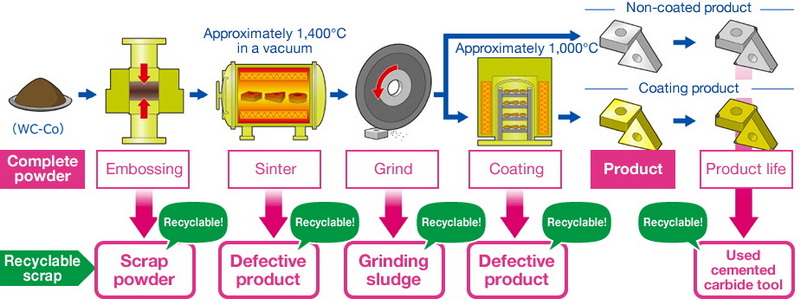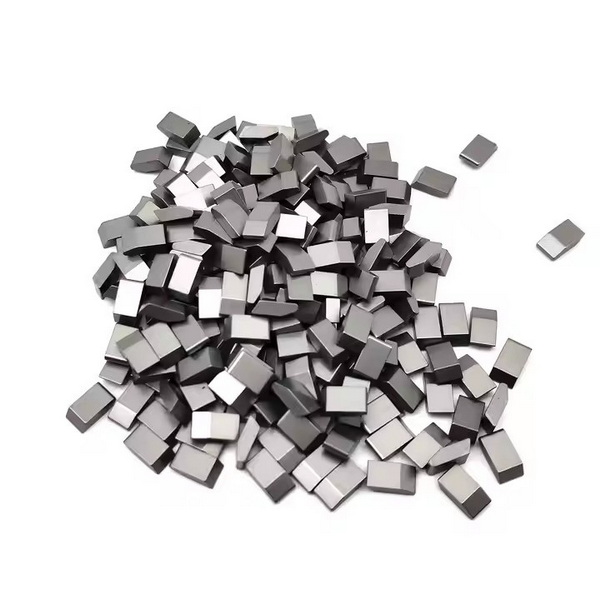Content Menu
● Introduction to Tungsten Carbide
>> Properties of Tungsten Carbide
● Manufacturing Process of Tungsten Carbide Parts
>> Sintering Process
● Applications of Tungsten Carbide Parts
● Challenges in Manufacturing Tungsten Carbide Parts
● Advances in Tungsten Carbide Technology
● Future Developments
>> Potential Applications of Composite Materials
● Conclusion
● FAQ
>> 1. What is the primary use of tungsten carbide in industry?
>> 2. How is tungsten carbide synthesized?
>> 3. What are the key challenges in machining tungsten carbide parts?
>> 4. What role does cobalt play in tungsten carbide?
>> 5. Are there any environmental concerns with tungsten carbide production?
● Citations:
Tungsten carbide is renowned for its exceptional hardness and durability, making it an ideal material for various industrial applications, including cutting tools, wear-resistant parts, and high-performance components. The process of manufacturing tungsten carbide parts involves several complex steps, from raw material selection to final product machining. This article will delve into the detailed process of creating tungsten carbide parts, highlighting key techniques, applications, and challenges.

Introduction to Tungsten Carbide
Tungsten carbide, with the chemical formula WC, is a compound of tungsten and carbon. It is known for its high hardness, wear resistance, and thermal conductivity, making it suitable for applications where high strength and durability are required. Tungsten carbide is often combined with cobalt to form cemented carbide, which enhances its toughness and reduces brittleness.
Properties of Tungsten Carbide
- Hardness: Tungsten carbide has a microhardness of approximately 17,300 MPa, comparable to diamond.
- Thermal Conductivity: It is a good conductor of heat, which is beneficial in high-temperature applications.
- Corrosion Resistance: Tungsten carbide is resistant to corrosion from water, hydrochloric acid, and sulfuric acid but dissolves in a mixture of nitric and hydrofluoric acids.
Manufacturing Process of Tungsten Carbide Parts
The manufacturing process involves several stages:
1. Batching and Mixing: The process begins with the selection and mixing of tungsten carbide and cobalt powders. The ratio of these components is crucial for achieving the desired properties in the final product. For example, increasing the cobalt content can enhance the toughness of the material but may reduce its hardness.
A[Batching and Mixing] --> B[Crushing and Drying]
B --> C[Binder Addition and Granulation]
C --> D[Pressing and Sintering]
D --> E[Machining]
2. Crushing and Drying: The mixed powders are crushed and dried to ensure uniformity and flowability. This step is critical for preventing agglomeration and ensuring consistent properties throughout the material.
3. Binder Addition and Granulation: A binder is added to the mixture, which is then dried and sieved to create a uniform granule size. The binder helps in maintaining the shape during the pressing process.
4. Pressing and Sintering: The granules are pressed into the desired shape using techniques such as uniaxial pressing or isostatic pressing. They are then sintered in a furnace at high temperatures (typically around 1,600°C) to form a solid part. Sintering can be performed using various techniques, including vacuum sintering or hot isostatic pressing, to achieve optimal densification and microstructure.
5. Machining: The sintered part is then machined using techniques such as EDM (Electrical Discharge Machining), CNC machining, or grinding to achieve precise dimensions. EDM is particularly useful for complex geometries due to its ability to machine hard materials without generating excessive heat.
Sintering Process
Sintering is a critical step that involves heating the pressed tungsten carbide parts in a controlled atmosphere to achieve densification and bonding. This process can be performed using various techniques, including vacuum sintering or hot isostatic pressing. Vacuum sintering helps in reducing oxidation and improving the material's purity, while hot isostatic pressing ensures uniform density throughout the part.

Applications of Tungsten Carbide Parts
Tungsten carbide parts are widely used in various industries due to their exceptional properties:
- Cutting Tools: Drills, milling cutters, and saw blades benefit from tungsten carbide's hardness and wear resistance. These tools are used in machining operations for metals, wood, and other materials.
- Wear-Resistant Parts: Used in high-stress environments such as mining and oil & gas industries. Tungsten carbide components are ideal for parts that need to withstand abrasive wear and high impact.
- Medical Instruments: Tungsten carbide is used in surgical instruments due to its corrosion resistance and durability. It is particularly useful in applications where biocompatibility and sterilization are required.
- Aerospace and Defense: Tungsten carbide is used in rocket nozzles and other high-temperature applications due to its thermal conductivity and resistance to thermal shock.
- Automotive Industry: Used in components like fuel injectors and valve seats due to its wear resistance and ability to withstand high pressures.
Challenges in Manufacturing Tungsten Carbide Parts
Despite its advantages, manufacturing tungsten carbide parts poses several challenges:
- High Production Costs: The raw materials and sintering process are expensive. Tungsten is a rare metal, and its extraction and processing contribute significantly to the overall cost.
- Complex Machining: Tungsten carbide is difficult to machine due to its hardness. Specialized equipment and techniques are required, adding to the production cost.
- Environmental Concerns: While tungsten carbide itself is not hazardous, the mining of tungsten can have environmental impacts. Efforts are being made to improve sustainability in tungsten sourcing and recycling.
Advances in Tungsten Carbide Technology
Recent advancements in technology have improved the efficiency and sustainability of tungsten carbide production:
- 3D Printing: Techniques like additive manufacturing are being explored for producing complex geometries without the need for extensive machining. This method allows for rapid prototyping and can reduce material waste.
- Recycling: Efforts are underway to recycle tungsten carbide scrap, reducing waste and conserving resources. Recycling can also help in reducing the environmental impact of tungsten mining.
- Nanomaterials: Research into nanostructured tungsten carbide aims to enhance its properties further, potentially leading to new applications. Nanomaterials can exhibit improved mechanical properties and thermal conductivity.
Future Developments
As technology continues to evolve, we can expect significant advancements in the production and application of tungsten carbide. Innovations in sintering techniques and the development of new binders could further enhance the material's properties. Additionally, the integration of tungsten carbide with other materials, such as ceramics or metals, may lead to the creation of composite materials with unique properties.
Potential Applications of Composite Materials
Composite materials combining tungsten carbide with other materials could find applications in advanced aerospace components, high-performance medical devices, and specialized cutting tools. These composites could offer improved thermal resistance, enhanced mechanical strength, and better corrosion resistance.
Conclusion
Manufacturing tungsten carbide parts involves a complex process that requires precise control over material selection, sintering conditions, and machining techniques. The unique properties of tungsten carbide make it indispensable in various industrial applications. However, challenges such as high production costs and complex machining processes need to be addressed to fully exploit its potential. Advances in technology, including additive manufacturing and recycling, offer promising solutions to these challenges.

FAQ
1. What is the primary use of tungsten carbide in industry?
Tungsten carbide is primarily used in the manufacture of cutting tools and wear-resistant parts due to its exceptional hardness and durability.
2. How is tungsten carbide synthesized?
Tungsten carbide is synthesized by heating tungsten oxide mixed with graphite (carbon) at high temperatures, typically above 1,200°C, in a process known as carburization.
3. What are the key challenges in machining tungsten carbide parts?
The key challenges include the high hardness of tungsten carbide, which makes it difficult to machine, and the need for specialized equipment like EDM or CNC machines.
4. What role does cobalt play in tungsten carbide?
Cobalt acts as a binder in cemented carbide, enhancing its toughness and reducing brittleness, allowing it to be used in applications requiring both hardness and impact resistance.
5. Are there any environmental concerns with tungsten carbide production?
While tungsten carbide itself is not hazardous, the mining of tungsten can have environmental impacts. Efforts are being made to improve sustainability in tungsten sourcing and recycling.
Citations:
[1] https://www.carbide-part.com/blog/tungsten-carbide-machining-process/
[2] https://www.refractorymetal.org/tungsten-carbide-uses-properties.html
[3] https://www.ee.cityu.edu.hk/~gchen/pdf/Writing.pdf
[4] https://www.kovametalli-in.com/manufacturing.html
[5] https://www.tungco.com/insights/blog/5-tungsten-carbide-applications/
[6] https://blog.csdn.net/ztf312/article/details/79551981
[7] https://www.carbide-products.com/blog/how-tungsten-carbide-parts-made/
[8] https://www.sollex.se/en/blog/post/about-cemented-tungsten-carbide-applications-part-1
[9] https://todaysmachiningworld.com/magazine/how-it-works-making-tungsten-carbide-cutting-tools/
[10] https://en.wikipedia.org/wiki/Tungsten_carbide
[11] https://ceramics.org/ceramic-tech-today/tungsten-carbide-made-easy-government-industry-academia-investigate-additively-manufacturing-cemented-carbide-parts/
















